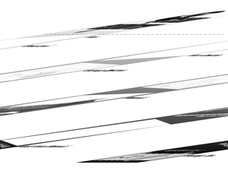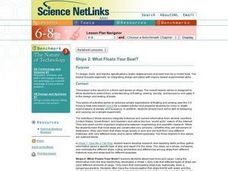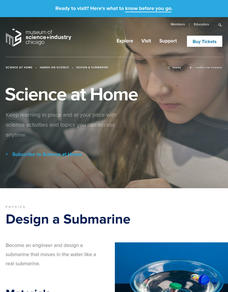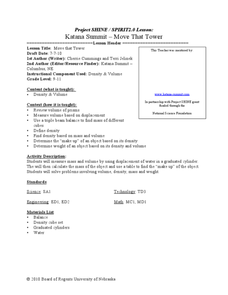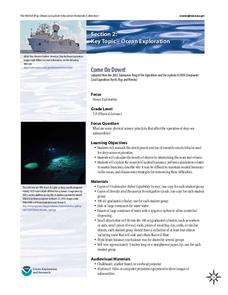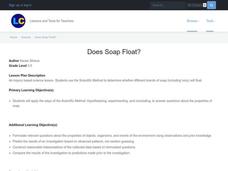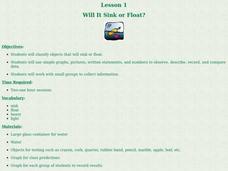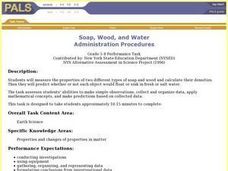Teach Engineering
Floaters and Sinkers
Whatever floats your boat. Young engineers learn about density by measuring the masses and volumes of boxes filled with different materials. Using their knowledge of densities, they hypothesize whether objects with given densities will...
Curated OER
Big Enough?
Students explore the concept of density and buoyancy. In this physics lesson, students discover the different factors that affect an object's density and buoyancy in water. Students conduct several investigations to further...
Curated OER
Liquid Rainbow
Students develop their own techniques for drawing a small sample of solutions into a straw. They hypothesize ways to increase the density of water, and discuss how salt-free rainwater tends to float on top of salty seawater.
Teach Engineering
Determining Densities
Don't be dense—use a robust resource. The second installment of a five-part Floaters and Sinkers unit has learners determine the densities of several objects. As part of the activity, they learn the displacement method for finding...
Curated OER
Ships 2: What Floats Your Boat?
Students design, build, and test the specifications (water displacement and load line) for a model boat. The instructional activity focuses especially on integrating design principles with inquiry-based experimental skills.
Curated OER
Call Me Bond, Hydrogen Bond
As amazing as James Bond is, the surface tension of water does not allow him to walk on it! In this series of little lab activities, physical scientists play with the properties of water due to the hydrogen bonds and resulting polarity....
Museum of Science
Design a Submarine
Don't just sink the boat. Using a closed container as a submarine, pupils experiment to see what to add to the container to make it float, sink to the bottom, and hover in the middle. After finding one option, learners see if they can...
Curated OER
Move that Tower
Students investigate ways to find the density of irregular shaped objects. For this physics lesson, students calculate density using its mass and volume. They explain why some objects float or sink in water.
Curated OER
Labeling Forces Correctly!
Define six common forces: propulsion, air resistance, water resistance, friction, gravity, and upthrust. A picture of a Smart Car is displayed with arrows showing all of the forces acting on it when it is motion. A picture of a rubber...
Curated OER
Ice Floats
Learners explore the changing density of water. In this physics lesson, students investigate how an object's density determines whether it will float or sink in water. They explain why this unique property of is important to living things.
NOAA
Come on Down!
What do we do when a dive is too dangerous for humans to accomplish? Send in the robots! Middle school scientists get acquainted with several different models of submersible robots in the second lesson of six from NOAA. Lab groups then...
Curated OER
Water and Ice
Students investigate the states of matter. In this physics lesson, students use water and ice to demonstrate the characteristics of a solid and liquid. Students record their observations as the state of the water changes.
Curated OER
Floating Soap
Students use the Scientific Method steps to complete an experiment on various brands of soap to determine their floating capabilities. In this scientific method lesson, students write a hypothesis about the ability of various soap bars...
Curated OER
Forces in Fluids
In this forces in fluids worksheet, students identify the principles behind the forces acting upon objects in fluids that make them float, lift and spray.
Curated OER
Will It Sink or Float?
Learners perform experiments to see if items will sink or float. For this sink or float lesson, students work in groups to make predictions, and record the results. After the experiments are complete learners make a book of the results.
Curated OER
Which Objects Will Sink or Float?
First graders work in cooperative groups and utilize a variety of materials to test objects ability to sink or float. In this sink or float lesson, 1st graders discover why some object sink and others float. Students will graph results...
Curated OER
Sink or Float
First graders explore items that sink or float. They cut and glue pictures of objects that they predict will sink or float. Students place thir pictures on a picture of a bucket of water. Students then color the objects that they had...
Curated OER
The Weight of Water
Students examine how salt water is more dense than fresh water. They discuss how manatees need to float and sink, conduct a sink or float experiment, and conduct an experiment with eggs and salt and fresh water.
Curated OER
Sink or Float Water Play Activity
Students experiment with different objects to see if they sink or float. They can also choose certain colored items if more review is necessary.
Curated OER
Sink or Float?
Students examine how weight and balance can effect if an item sinks or floats. They listen to the book "Who Sank the Boat?" by Pamela Allen, and discuss how the smallest animal sank the boat. Students then conduct an experiment in...
Curated OER
Density in Relation to Float and Sink
Students explore the concept of density. In this density lesson, students determine the density of various objects. Students use the density of the various objects to predict the density of various unknown solutions.
Curated OER
Water Exploration Station
Students explore the characteristics of water. In this water exploration lesson, students participate in various learning centers to inquire how water drains and how to increase the flow of water. Students use estimation and measurement...
Curated OER
Soap, Wood, and Water
Learners measure the properties of two different types of soap and wood and calculate their densities. Then they predict whether or not whether or not each object would float or sink in fresh or salt water.

